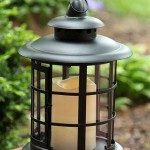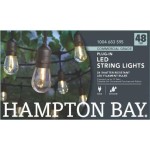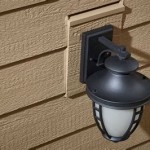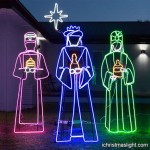Motion Sensor Light Outdoor Instructions: A Comprehensive Guide
Outdoor motion sensor lights offer a valuable combination of security, convenience, and energy efficiency. They deter potential intruders by illuminating designated areas when movement is detected, provide hands-free lighting for pathways and entryways, and conserve energy by only activating when needed. Successful installation and optimal performance hinge on understanding the various components, settings, and potential troubleshooting steps. This article provides a detailed guide to installing, configuring, and maintaining outdoor motion sensor lights.
Before commencing any installation, adherence to safety protocols is paramount. De-energize the circuit at the breaker box to prevent electrical shock. Consult local electrical codes to ensure compliance, and if unfamiliar with electrical work, engage a qualified electrician. Gather all necessary tools, including a screwdriver set, wire strippers, wire connectors, electrical tape, a level, and safety glasses. Ensure the chosen motion sensor light fixture is suitable for outdoor use and is compatible with the existing electrical system.
Understanding the Components of a Motion Sensor Light
A typical motion sensor light assembly comprises several key components, each contributing to its functionality. Familiarity with these elements facilitates proper installation and fine-tuning of the device.
The light fixture itself houses the bulb or LED array responsible for illumination. Check the wattage and voltage requirements of the fixture and ensure compatibility with the power supply. The mounting bracket secures the fixture to the designated surface, be it a wall, eave, or post. Proper mounting is crucial for stability and optimal sensor coverage.
The motion sensor, the core of the system, utilizes various technologies to detect movement. Passive infrared (PIR) sensors are the most common, detecting changes in infrared radiation emitted by warm objects, such as people and animals. Microwave sensors emit microwave radiation and detect changes in the reflected signal caused by moving objects. Dual-technology sensors combine PIR and microwave sensing to reduce false alarms.
The control panel, typically located on the underside or back of the fixture, houses the adjustment settings. These settings typically include sensitivity, duration, and range. Sensitivity controls the level of movement required to trigger activation, while duration determines how long the light remains on after motion is detected. Range dictates the distance within which the sensor can detect movement. Some models may also feature a dusk-to-dawn setting, enabling the light to operate as a standard outdoor light during darkness and switch to motion-activated mode at other times.
Wiring connections facilitate the flow of electricity to the fixture. These connections typically involve a hot wire (usually black), a neutral wire (usually white), and a ground wire (usually green or bare copper). Secure and correct wiring is essential for safe and reliable operation.
Installation Procedure: A Step-by-Step Guide
The installation process involves removing existing fixtures (if applicable), mounting the new fixture, connecting the wiring, and adjusting the settings. Following these steps ensures a secure and functional installation.
First, disconnect the power supply at the breaker box. Remove the existing light fixture, if present, carefully disconnecting the wires and noting their arrangement. Inspect the junction box for any damage or corrosion. Clean the junction box and ensure it is securely mounted. Attach the mounting bracket of the new motion sensor light to the junction box, ensuring it is level and securely fastened. Consider using weatherproof sealant around the bracket to prevent water intrusion.
Connect the wiring according to the manufacturer's instructions and local electrical codes. Typically, the black (hot) wire from the house wiring connects to the black wire of the fixture, the white (neutral) wire from the house wiring connects to the white wire of the fixture, and the green or bare copper (ground) wire from the house wiring connects to the green or bare copper wire of the fixture. Use wire connectors to securely join the wires, and wrap the connections with electrical tape for added insulation. Ensure no bare wires are exposed.
Carefully tuck the wires into the junction box and attach the light fixture to the mounting bracket. Ensure the fixture is securely attached and level. Install the light bulb or LED array according to the manufacturer's instructions. Switch the power back on at the breaker box. Test the light by walking within the sensor's designated range. Adjust the sensor settings as needed to achieve the desired sensitivity, duration, and range.
For optimal performance, position the sensor away from potential sources of false alarms, such as moving trees, busy streets, and heat-generating appliances. Regularly inspect the fixture for damage or corrosion. Clean the sensor lens periodically to remove dust and debris, ensuring accurate detection.
Troubleshooting Common Issues and Optimizing Performance
Even with careful installation, some common issues may arise. Addressing these issues promptly ensures continued functionality and optimal performance. Several factors contribute to improper operation, often addressable through simple adjustments and preventative maintenance.
One common problem is false triggering, where the light activates without any apparent movement. This can be caused by overly sensitive settings, positioning the sensor near heat sources or moving objects, or external interference. Lowering the sensitivity setting, repositioning the sensor, or employing a dual-technology sensor can mitigate false triggering.
Another issue is the light failing to activate when movement is present. This could be due to a low sensitivity setting, a blocked sensor lens, a malfunctioning sensor, or a blown bulb. Increasing the sensitivity setting, cleaning the lens, replacing the bulb, or contacting the manufacturer for sensor replacement can resolve this issue.
Shortened run times can stem from low battery (if applicable for solar models), incorrect timer settings, or frequent triggering. Replacing the battery, adjusting the timer settings, or addressing the root cause of the frequent triggering can extend the run time.
To optimize performance, consider the specific needs of the location where the light is installed. For example, in areas prone to wildlife activity, lowering the sensitivity or employing a dual-technology sensor may be necessary to minimize false alarms. In areas requiring wider coverage, a light with adjustable sensor heads can be beneficial. Regularly test the light and sensor to ensure they are functioning correctly. Replace bulbs or batteries as needed to maintain optimal brightness and detection range. Clean the lens regularly to remove dust and debris that can impair sensor performance. Periodically inspect the wiring connections for corrosion or damage and repair as needed. Consider using energy-efficient LED bulbs to reduce energy consumption and extend bulb life. By implementing these measures, the motion sensor light can provide reliable security, convenience, and energy savings for years to come.
Maintaining proper grounding and weatherproofing is crucial for safety and longevity. Ensure the grounding wire is securely connected to the junction box and the fixture. Use weatherproof sealant or gaskets to prevent water intrusion into the junction box and the fixture. Inspect the fixture regularly for signs of damage or corrosion, and address any issues promptly. By adhering to these safety precautions and maintenance practices, the motion sensor light can provide years of reliable service.

Motion Sensor Wiring Diagram Lights Outdoor

Motion Sensor Lights Tips To Reset Detector

Installation Instructions Pdl 140 Degrees Outdoor Motion Clipsal

Solar Lights Outdoor Upgraded 74 Led Motion Sensor Light With 3 Heads

Lepro 20w Security Lights Outdoor Motion Sensor 1700 Lumen Pir Light Ip65 Waterproof Flood

Festive Lights Bl037 Outdoor Security Light Instruction Manual

Harbor Breeze Jel1691a 1 Light 11 75 In Brushed Nickel Motion Sensor Outdoor Wall Instruction Manual

Motion Sensor Outdoor Lights 3 Lighting Modes Farmhouse Barn Light 2pack Black Dusk To Dawn Gooseneck Porch Fixture Wall Mount Waterproof Exterior For House Outside Garage Com

Lamomo Lbjking Instruction Manual

Patriot Lighting Motion Sensor Instructions Exterior Light Fixtures Outdoor Wall







